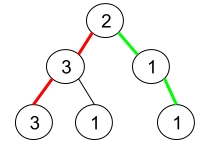1457. Pseudo-Palindromic Paths in a Binary Tree
Problem Statement
Given a binary tree where node values are digits from 1 to 9. A path in the binary tree is said to be pseudo-palindromic if at least one permutation of the node values in the path is a palindrome.
Return the number of pseudo-palindromic paths going from the root node to leaf nodes.
Example 1:

Example 2:

Example 3:
Constraints:
The number of nodes in the tree is in the range
[1, 105].1 <= Node.val <= 9
Intuition
Links
Video Links
https://www.youtube.com/watch?v=P0bAPxMkjnk&t=32s&ab_channel=AryanMittal
Approach 1:
Approach 2:
Approach 3:
Approach 4:
Similar Problems
Previous1239. Maximum Length of a Concatenated String with Unique CharactersNextCopy of Copy of Copy of Copy of Template
Last updated